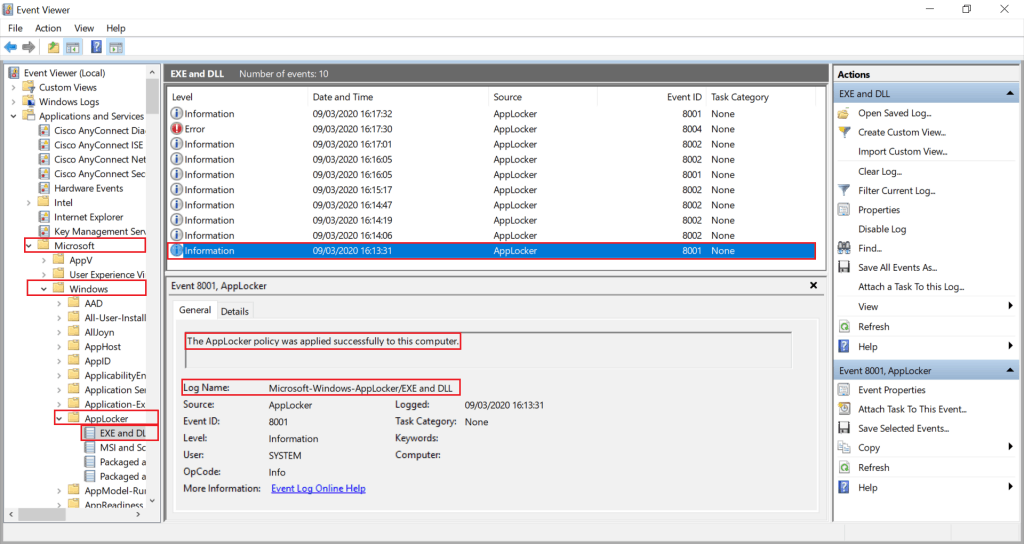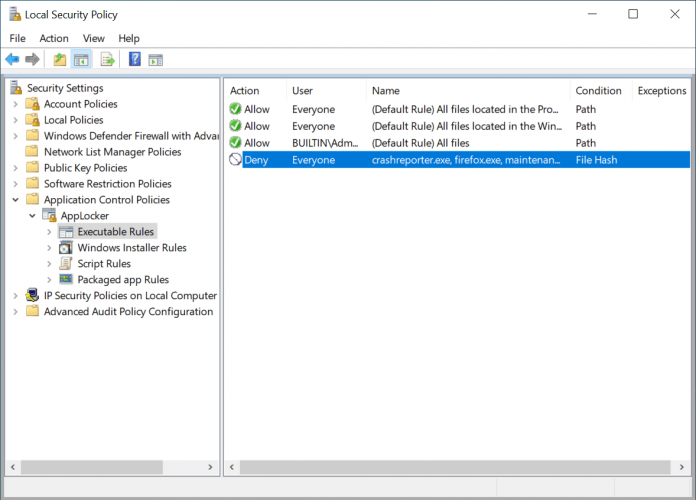

Then click next until you finish out the wizard and create the policy.
Applocker policy intune code#
Vendor/MSFT/AppLocker/AppLocker/ApplicationLaunchRestrictions/apps/EXE/PolicyĬhoose String as the Data type and then paste the XML code you copied into the Value box as shown below. In the OMA-URI textbox you will input the following path: Here you will need to add the OMA-URI settings. Using the wizard, name the policy and go to configuration settings. Now open the saved XML file with a text editor and highlight and copy all the content within the AppLocker tags as shown in the screenshot below.
Applocker policy intune windows 10#
Now import that XML file into MEM by going to Devices > Configuration profiles > Create policy > Windows 10 and later > Templates and choose Custom and click the Create button. Name the policy and save it as an XML file. But what about Windows 10 devices that are managed by Microsoft Endpoint Manager or similar MDM provider? In that instance, you can export the AppLocker rules by right-clicking on AppLocker and exporting the policy as shown below. Now assign the GPO to the targeted computers. Now you will have two rules as shown below. This time we will use environmental variables for the file path which is %SYSTEM32\ReAgentc.exe. Now create another executable rule using the same process. For this rule let’s choose:Ĭontinue with the Wizard.


There are two path executables we need to block. In the next screen choose “Path” as the primary condition. You can target a specific group or just go with the default Everyone group as shown below. Using the wizard, choose Deny as the action. Right-click and select Create New Rule as shown in the screenshot below. Using Windows Group Policy Management Editor, create a GPO and go to Computer Configuration > Security Settings > Application Control Policies > AppLocker > Executable Rules. Fortunately, there is an easy way to do it using AppLocker to create a policy that can be deployed using Group Policy or your preferred MDM solution that will prevent standard users from implementing a factory reset. For those computers managed by an MDM provider, policies and applications will be deployed once the computer connects to the Internet, making any acquired freedom brief, but perhaps meaningful enough to be worth the effort to the student.Įven if you don’t work for a school system, you still might want to stop your users from resetting their devices.
Applocker policy intune install#
What’s more, a PC tech may have to manually deploy a package file to install the required applications, consuming precious time from both the student and the technician. For computers that are managed byGroup Policy, students that reset their devices off premise will enjoy a newfound freedom until the computer returns to campus and receives its assigned policies once again. It also gives them access to the command prompt screen and other things. This of course starts the computer with a clean slate, giving students time to make local accounts on their device. This gets them to the Advanced Startup screen where they can then reset the device. Even if students can’t get to system settings, they can always hold down the shift key while they use the mouse to select the Restart option from the Windows Start button. A common ploy by the students is to reset their devices to factory default to bypass enforced security policies. Anyone who has been a Windows device admin for a school system that implements a student laptop program is aware of the constant battle to keep students in check when it comes to their devices. Vendor/MSFT/AppLocker/ApplicationLaunchRestrictions/12345/DLL/Policy Vendor/MSFT/AppLocker/ApplicationLaunchRestrictions/12345/EXE/Policy Vendor/MSFT/AppLocker/ApplicationLaunchRestrictions/12345/StoreApps/Policy Use all the default rules that have been added below in the following scripts. NOTE: Also extract the default rules for DLL files, MSI and AppX to ensure all applications function as normal and we are only blocking the required access. The default values which are created will allow all OSDRIVE data and ProgramFiles data but this is not enough for Teams and OneDrive to function. The XML also contains the appdata locations as without this Microsoft Teams and OneDrive will not work. The following xml file will block CMD, powershell and powershell ise to run for domain users but still allow domain administrators to run.


 0 kommentar(er)
0 kommentar(er)
